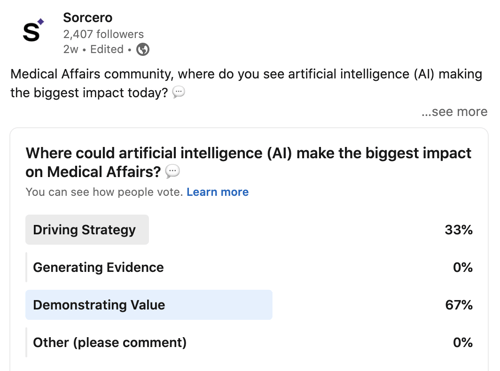Medical Affairs (MA) has greater strategic influence than ever before.
Medical Affairs professionals are experts in communicating scientific knowledge and value across life sciences and healthcare. How are internal stakeholders measuring the impact? It hasn't been a straight path.
Recently, Sorcero conducted a LinkedIn survey about the impact of artificial intelligence (AI) on MA.
According to the poll, 66% of respondents said that AI could have the biggest impact on demonstrating value in medical affairs. Why is better data critical when it comes to showcasing value?
Data is an essential component of measuring performance in any function of any industry. Defining the value proposition of a field’s impact is not unique to MA. Businesses and healthcare use it as a way to identify the “benefits, costs and value that an organization can deliver to its customers.”
Numbers are just one piece of this larger puzzle.
What is the value of Medical Affairs?
The value of Medical Affairs stretches into and beyond trends and figures.
MA professionals bring years of invaluable scientific training, education, and experience into each action they take. The value of this expertise cannot be overstated, particularly when considering its potential effects on patient outcomes. Its interconnectivity to commercial and R&D, as well as health care providers and even patients, brings it to the center of the landscape.
This inherent value and rise in strategic impact bring to mind the difference between having value and showing value.
There’s no question of the former. MA is focused on delivering value to healthcare professionals, researchers, key opinion leaders, patients, and beyond, but how can it most effectively present that impact? How can it best share the full story of its contribution?
There are three layers to consider when painting the full picture:
- The Quantitative
- The Qualitative
- Everything that lies between
When these layers are combined, they provide a clear image - in context - of the importance of medical affairs within the life sciences.
.png?width=600&name=Quantitative%20(1).png)
Clear Outcomes: Medical Affairs Quantitative Metrics
Establishing quantitative KPIs has been a major initiative across MA. Quantitative metrics enable teams to track performance and adjust their strategies as appropriate.
Pharmaceutical and medical device companies vary internally, so this process will shift depending on the team. From Medical Science Liaisons (MSLs) to leadership, it's important to tie each KPI to an organizational goal during this stage. This ensures that each action is tied to an outcome that benefits relevant stakeholders.
Some examples of these metrics include:
- How many new KOLs are identified and engaged with?
- How many referrals are generated?
- How many follow-up meetings are arranged?
- What is the length of each meeting?
- How many insights are collected?
- How many insights become actionable?
- How long does it take before insights are identified as actionable?
Below the Surface: Medical Affairs Qualitative Outcomes
In medical affairs, qualitative data arises each time they receive feedback from an HCP, engage with a KOL, participate in online forums or discussions, or scan social media feeds.
These actions can result in outcomes that are harder to interpret than others. Qualitative metrics are often more difficult to analyze than quantitative because the analysis is subjective and inductive. However, this feedback and sentiment analysis is worth collecting and assessing.
While the quantitative gives us the what, the qualitative can give us the why. It can be applied by examining some areas including:
- Trust and Credibility:
- Do HCPs trust that MA is delivering unbiased, credible scientific information targeted to their therapeutic area and patient needs?
- How often and in what ways do they engage with the content you provide?
- Do they share feedback? What is the sentiment of the feedback?
- Education:
- Do healthcare providers have a deeper understanding and ability to speak to your educational content after engaging with it?
- Are external stakeholders utilizing your educational content across different formats and avenues?
- Are you receiving positive feedback and reviews from those who have engaged with your educational content? What is the sentiment of the feedback? How have they implemented it?
- Insights:
- What are the sources of insights your team is gathering?
- What are the degrees of impact that insights have on the organization?
- How are insights being implemented?
- What types of actions are occurring based on insights?
These are just a few examples of questions to consider within your Medical Affairs team. Each team will have different goals, processes, and analyses. The overall value of collecting and interpreting this information remains the same.
While this can be done manually, there are key benefits to using artificial intelligence to speed up the process.
- Centralize information and data
- Connect quantitative to qualitative outcomes
- Identify trends in near real-time
- Sentiment analysis
- Internal visibility
Going Deeper: Between The Lines of Medical Affairs Value
While quantitative metrics enable medical affairs to take a look at key outputs, the qualitative can help assess key outcomes. Together, they may identify new connections and trends.
There may be pieces of information that could not have seemed that important or that valuable at the time. Yet when placed within the full context, they draw new attention to a specific action or relationship.
Telling the Full Story: The Range of MA Impact
As MA has elevated from a position of support to strategic leadership, there’s been an ongoing need to identify, track, and act upon key performance indicators (KPIs). One key challenge to overcome has been defining the value of an action on its impact.
How can an organization successfully connect a KOL conversation to a business outcome? What does that measurement process look like? How can teams ensure that attributions are accurate and worth the investment, from both a time and cost perspective?
Once this process has been identified, it can be automated and augmented through artificial intelligence. AI has the ability to ingest content and data from a variety of sources, pull it together, and provide metrics and visualizations to analyze. In a few clicks, internal stakeholders can reference the same set of data as MA. It provides clarity.
If you’d like to learn more about the types of capabilities artificial intelligence can provide to Medical Affairs, a member of our team would be happy to connect.
.png?width=300&name=Blog%20Headers%20(10).png)



